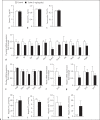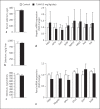In vivo Effects of Repeated Thyronamine Administration in Male C57BL/6J Mice
- PMID: 29594048
- PMCID: PMC5836237
- DOI: 10.1159/000481856
In vivo Effects of Repeated Thyronamine Administration in Male C57BL/6J Mice
Abstract
Objectives: Thyronamines are decarboxylated and deiodinated metabolites of thyroid hormones (THs). Of all possible thyronamine variants, only 3-iodothyronamine (3-T1AM) and iodine-free thyronamine (T0AM) have been detected in vivo. While intensive research has been done on the (patho-)physiological action of 3-T1AM, the role of T0AM has been studied less intensively.
Study design: We determined whether a single pharmacological dose (50 mg/kg, i.p.) or repeated administration (5 mg/kg/day, i.p., for 7 days) of T0AM affects metabolism, cardiovascular function, or thermoregulation in male C57BL/6J mice. Since selenium (Se) is important for proper TH function and Se metabolism is affected by TH, we additionally analyzed Se concentrations in liver, serum, and kidney using total reflection X-ray analysis.
Results: A single injection of T0AM had no effect on heart rate, temperature, or activity as assessed by radio telemetry. Likewise, daily administration of T0AM did not alter body weight, food or water intake, heart rate, blood pressure, brown adipose tissue thermogenesis, or body temperature, and no significant differences in hepatic glycogen content or mRNA expression of genes involved in cardiovascular function or metabolic control were determined. Also, the X-ray analysis of Se concentrations revealed no significant changes. However, hepatic T0AM was significantly increased in the treated animals.
Conclusions: In summary, our data demonstrate that T0AM elicits no obvious metabolic, cardiovascular, or thermoregulatory activities in mice. As T0AM does also not interfere with TH or Se metabolism, we conclude that the deiodination of 3-T1AM to T0AM constitutes an efficient inactivation mechanism, terminating the actions of the more powerful precursor.
Keywords: 3-Iodothyronamine; Brown adipose tissue; Heart rate; Metabolism; Thermoregulation; Thyroid hormone; Trace elements.
Figures






Similar articles
-
3-Iodothyronamine Decreases Expression of Genes Involved in Iodide Metabolism in Mouse Thyroids and Inhibits Iodide Uptake in PCCL3 Thyrocytes.Thyroid. 2017 Jan;27(1):11-22. doi: 10.1089/thy.2016.0182. Epub 2016 Dec 21. Thyroid. 2017. PMID: 27788620
-
Thyronamines and Derivatives: Physiological Relevance, Pharmacological Actions, and Future Research Directions.Thyroid. 2016 Dec;26(12):1656-1673. doi: 10.1089/thy.2016.0178. Epub 2016 Nov 9. Thyroid. 2016. PMID: 27650974 Review.
-
Cardiac actions of thyroid hormone metabolites.Mol Cell Endocrinol. 2017 Dec 15;458:76-81. doi: 10.1016/j.mce.2017.01.003. Epub 2017 Jan 7. Mol Cell Endocrinol. 2017. PMID: 28069537 Review.
-
Thyronamines are substrates for human liver sulfotransferases.Endocrinology. 2007 Apr;148(4):1921-7. doi: 10.1210/en.2006-1172. Epub 2007 Jan 4. Endocrinology. 2007. PMID: 17204552
-
Metabolic effects of thyroid hormone derivatives.Thyroid. 2008 Feb;18(2):239-53. doi: 10.1089/thy.2007.0248. Thyroid. 2008. PMID: 18279024 Review.
Cited by
-
N- and O-Acetylated 3-Iodothyronamines Have No Metabolic or Thermogenic Effects in Male Mice.Eur Thyroid J. 2020 Feb;9(2):57-66. doi: 10.1159/000504887. Epub 2019 Dec 20. Eur Thyroid J. 2020. PMID: 32257954 Free PMC article.
-
3-Iodothyronamine Activates a Set of Membrane Proteins in Murine Hypothalamic Cell Lines.Front Endocrinol (Lausanne). 2018 Sep 11;9:523. doi: 10.3389/fendo.2018.00523. eCollection 2018. Front Endocrinol (Lausanne). 2018. PMID: 30298050 Free PMC article.
-
Vascular Endothelial Growth Factor (VEGF) Induced Downstream Responses to Transient Receptor Potential Vanilloid 1 (TRPV1) and 3-Iodothyronamine (3-T1AM) in Human Corneal Keratocytes.Front Endocrinol (Lausanne). 2018 Nov 22;9:670. doi: 10.3389/fendo.2018.00670. eCollection 2018. Front Endocrinol (Lausanne). 2018. PMID: 30524369 Free PMC article.
-
Comparative Transcriptome Analysis Reveals the Potential Cardiovascular Protective Targets of the Thyroid Hormone Metabolite 3-Iodothyronamine (3-T1AM).Biomed Res Int. 2020 Jun 19;2020:1302453. doi: 10.1155/2020/1302453. eCollection 2020. Biomed Res Int. 2020. PMID: 32685439 Free PMC article.
-
The Colorful Diversity of Thyroid Hormone Metabolites.Eur Thyroid J. 2019 Jun;8(3):115-129. doi: 10.1159/000497141. Epub 2019 May 21. Eur Thyroid J. 2019. PMID: 31259154 Free PMC article. Review.
References
-
- Scanlan TS, Suchland KL, Hart ME, Chiellini G, Huang Y, Kruzich PJ, Frascarelli S, Crossley DA, Bunzow JR, Ronca-Testoni S, Lin ET, Hatton D, Zucchi R, Grandy DK. 3-Iodothyronamine is an endogenous and rapid-acting derivative of thyroid hormone. Nature medicine. 2004;10:638–642. - PubMed
-
- Hoefig CS, Köhrle J, Brabant G, Dixit K, Yap B, Strasburger CJ, Wu Z. Evidence for extrathyroidal formation of 3-iodothyronamine in humans as provided by a novel monoclonal antibody-based chemiluminescent serum immunoassay. J Clin Endocrinol Metab. 2011;96:1864–1872. - PubMed
-
- Liggett SB. The two-timing thyroid. Nat Med. 2004;10:582–583. - PubMed
-
- Schanze N, Jacobi SF, Rijntjes E, Mergler S, Del Olmo M, Hoefig CS, Khajavi N, Lehmphul I, Biebermann H, Mittag J, Kohrle J. 3-Iodothyronamine decreases expression of genes involved in iodide metabolism in mouse thyroids and inhibits iodide uptake in PCCL3 thyrocytes. Thyroid. 2017;27:11–22. - PubMed
LinkOut - more resources
Full Text Sources
Other Literature Sources
Research Materials

